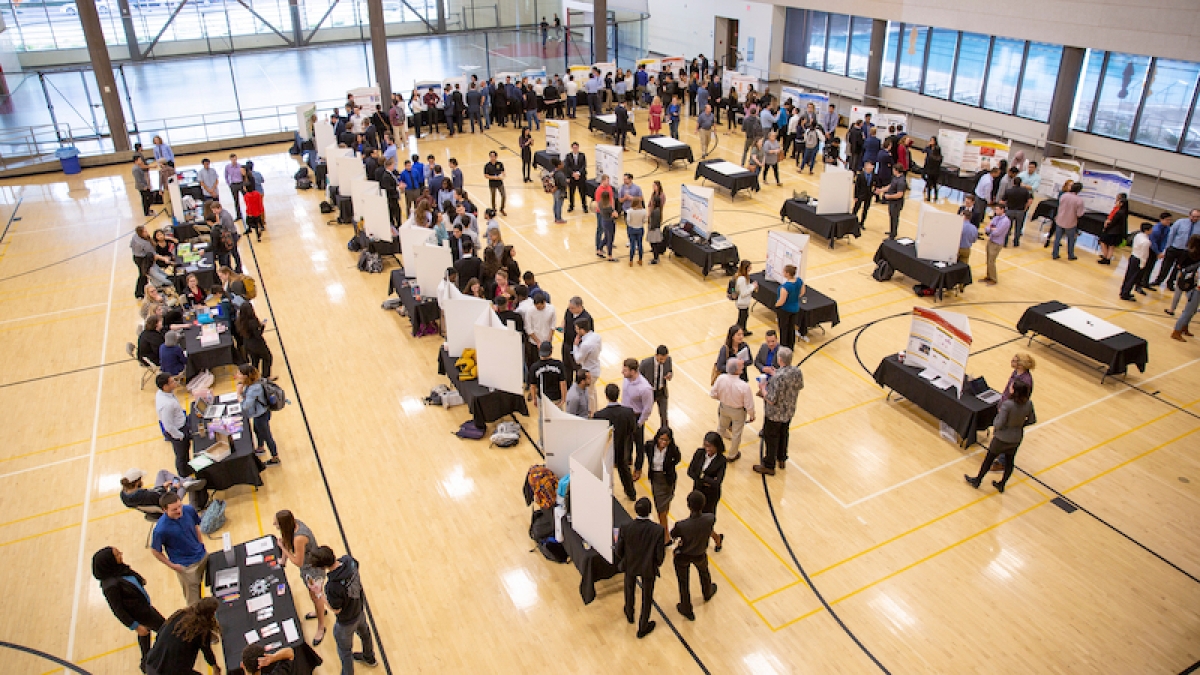Capstone projects confirm ASU students ready for industry

Capstone projects culminate with a showcase assembling students, faculty and other stakeholders to review and celebrate the results of each team's work, such as during this December 2019 event for the School of Biological and Health Systems Engineering. Photo by Erika Gronek/ASU
Undergraduate students in Arizona State University's Ira A. Fulton Schools of Engineering devote a large part of their final year to completing a capstone project, which demonstrates the insights and skills they have developed at ASU. Working in teams of two to seven people to solve a practical industrial problem, the experience is both a significant challenge and a source of substantive growth.
“It’s an opportunity to practice engineering design in a low-risk environment,” said Ryan Meuth, a capstone project coordinator and a senior lecturer in the School of Computing, Informatics, and Decision Systems Engineering, one of the six Fulton Schools. “Students can learn from their mistakes without any real career impact. So, the capstone course offers a meaningful transition from the academic world to the professional one.”
For many students, capstone work involves direct contact with industry professionals who sponsor a project and liaise with student teams as they tackle the challenges of solving their assigned problem.
Sidney Davis and four fellow computer systems engineering majors have applied their efforts this year to a project sponsored by General Dynamics. Davis appreciates that this experience has been broader than tackling a single technical problem.
“We essentially went through an entire development process, and we shaped the direction of our work,” she said. “We explored an open-source cloud technology in order to demonstrate the advantages and disadvantages of its use at the company. And our exposure to the technology involved was really valuable. The platform we used is being adopted by all of the big tech companies, so this experience could open doors to jobs.”
Brett Goldsmith, an electrical systems engineering major, worked with his capstone team on a design opportunity posed by NMG Aerospace, an Ohio-based engineering and manufacturing business with a significant presence in Arizona. Goldsmith and his peers have been supporting NMG in exploring improvements to a flight-critical airliner safety system.
“This project has shown me how a lot of the things I have learned in my program are directly applicable to potential career opportunities,” he said.
Other capstone projects include a Mayo Clinic initiative to enable a mobile diagnostic tool to scan patient retinas and a Maricopa County Department of Transportation effort to design a robotic traffic cone placement system to improve safety during emergency incident responses.
Work on these projects involves regular interaction among student team members, university faculty and industry sponsors. Consequently, social distancing measures applied in response to COVID-19 this spring have made already challenging endeavors even more difficult. At the same time, the reality of distance learning and remote working has presented opportunities for some capstone teams.
“Many tools and test facilities at ASU have been unavailable, so we had to figure out how to get hardware to students, since they make progress on their work at all times — days, evenings and weekends,” Meuth said. “To that end, one team was tasked with building a ‘vending machine’ device that permits students to check out needed replacement parts without an instructor or teaching assistant present.”
Adaptation to current events extends beyond actual project completion. It also demands innovation in the recognition of these yearlong efforts.
At The Polytechnic School, for example, the capstone project process culminates with the Innovation Showcase, a large and impressive gathering of students, faculty and other stakeholders who review the results of each team’s work. But rather than cancel the event this spring, an alternative model was created.
“Our new plan is based on running five videoconference meetings in parallel,” said Darryl Morrell, associate professor of engineering at The Polytechnic School and a capstone project coordinator. “This accommodates our 52 student teams, giving each a 20-minute segment to present their work and answer questions. We have been inviting our industry partners as well as others interested in the capstones, and we have a schedule highlighting all of the showcase presentations.”
Even with this virtual approach, the buoyant spirit of the showcase remains the same.
“We celebrate our students’ abilities to bring together all the components of their education to produce something innovative,” Morrell said. “We also build bridges to our industry partners, which benefits our students with increased job opportunities, as well as our programs through added expertise and resources.”
Indeed, commercial connections are a significant and multifaceted benefit of engineering capstone projects at ASU.
“As our students demonstrate their technical, project management and budgeting skills, our industry partners receive a nine-month interview with the best and brightest new talent,” said Tim Beatty, associate director of the Business Engagement Catalyst for the Fulton Schools.
More Science and technology

Compact X-ray laser lab aims to reveal deep secrets of life, matter and energy
X-rays allow us to view inside the human body to diagnose broken bones and other hidden problems. More recent X-ray advances are…

Apollo lunar samples enable ASU researcher to pinpoint moon’s crystallization timeline
A team of researchers, including Arizona State University geochemist Melanie Barboni, in collaboration with scientists from The…

NASA launches space telescope to chart the sky and millions of galaxies
California’s Vandenberg Space Force Base was the site for Tuesday’s 8:10 p.m. launch of the NASA SPHEREx mission aboard a SpaceX…

